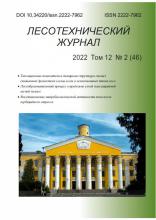Bratsk, Irkutsk region, Russian Federation
Bratsk, Irkutsk region, Russian Federation
Trees and shrubs grown in ordinary plantings along city streets play a role of barrier between residential developments and highway, protecting residential area from adverse impact of motor vehicles. Different varieties of poplar have received large spread in the greening of cities. This unpretentious, resistant to dust and gases, fast growing species is able to successfully protect living space from harmful emissions. In Bratsk, with harsh, sharply continental climate and adverse environmental conditions, balsam poplar (Populus balsamifera L.) is dominant variety of species. The age of trees currently close to critical one (40-50 years), therefore there is a need of gradual replacement of plantations of Populus balsamifera L. in urban plantings. In one of the residential areas of the city a study on plantations of poplars was conducted. Samples of 653 tree were studied in a visual way: damage of different nature are fixed: thinning of branches, thinning of crown, frost cracks, side-dry tree, mechanical damage, curvature of trunk, presence of rot, hollows, exfoliation, contaminants. We compared the trees subjected to pruning of the crown and trees without pruning. It was discovered that beheading trees are damaged more. 102 trees were examined using Resistograph 4450 device. This method, which is less traumatic for the tree, allows to accurately determine the presence of rot in the trunk. Central rot was detected in different degrees of spread in all trees. There are trees, which state is normal in visual inspection, but the results of instrumental evaluation show internal damage to the trunk by more than 80 %. The greatest danger is the trees with inclination of the trunk, asymmetry of crown. In the presence of the central rot, such trees are considered hazardous ones. 17 of 102 trees were considered hazardous and they are recommended for cutting. A significant part of plantations are planted with violation of the rules: distance from the edge of the roadway to the axis of tree does not comply with the regulatory, which affects traffic safety and condition of plantations. On the basis of conducted research, conclusions are formulated and recommendations on the improvement of urban spaces are proposed, restoration of their environmental and aesthetic functions: to gradually replace old plantings of poplars to other dust - and gas resistant species, expanding the range of vegetation; to comply with the rules in cutting of poplars; to carry out agricultural activities, to remove damaged trees on time.
balsam poplar, resistograph, crown reduction pruning, damaged, rot, inclination of trunk, cutting.
Состояние вопроса. Главной составляющей экологической инфраструктуры города является система зелёных насаждений общего пользования: городские сады, парки, скверы, бульвары [4, 11]. Значительная часть городских насаждений представлена в виде рядовых посадок, расположенных вдоль автомобильных дорог и магистралей. Эти деревья и кустарники принимают на себя основной удар от неблагоприятных воздействий природных и антропогенных факторов: повышенных и пониженных температур воздуха, ветра, пыли, выхлопных газов, антигололедных реагентов, рекреационной нагрузки. Искусственное освещение улиц нарушает световой режим, использование ливневой канализации для стока поверхностных вод приводит к недостатку влаги. В результате древесно-кустарниковая растительность в примагистральных полосах подвергается различного рода повреждениям и болезням, что, в конечном счете, снижает продолжительность жизни зеленых насаждений.
1. Bakulin, T.V. Ispol'zovanie topolya v ozelenenii promyshlennykh gorodov Sibiri [The use of poplar in the greening of industrial cities in Siberia], Sibirskii ekologicheskii zhurnal, 2005, No 4, pp. 563-571. EDN: https://elibrary.ru/HRVBQH
2. Bezuglaya, E. Yu. Chem dyshit promyshlennyi gorod [What an industrial city breathes], Leningrad. Gidrometeoizdat, 1991, 251p.
3. Goryshina, E.L. Rasteniya v gorode [Plants in the city], Leningrad Izd-vo LGU, 1991. - 184 p.
4. Grigor'ev, V.A. Ekologizatsiya gorodov v mire, Rossii, Sibiri [Ekologizatsiya gorodov v mire, Rossii, Sibiri], Novosibirsk, 2001, - 60 p.
5. Dorofeeva, T.B. Problemy analiza sostoyaniya zelenykh nasazhdenii v usloviyakh Sankt-Peterburga i perspektivy ozeleneniya (na primere otdel'nykh vidov rodov Populus, Ulmus, Tilia) [Problemy analiza sostoyaniya zelenykh nasazhdenii v usloviyakh Sankt-Peterburga i perspektivy ozeleneniya (na primere otdel'nykh vidov rodov Populus, Ulmus, Tilia)], Zhizn' i bezopasnost', 2004, No 2, pp.96-106.
6. Mikhailov, N. I. Sibir' 2-e izd., pererab. i dop. [Siberia 2 nd ed., Pererab. And additional.], Moskva: Gosudarstvennoe izdatel'stvo geograficheskoi literatury, 1956, 380 p.
7. Gosudarstvennyi doklad [Ministry of Natural Resources and Ecology Irkutsk region], 2015, 328 p.
8. Runova, E.M. Populus balsamifera v ozelenenii Bratska [Populus balsamifera v ozelenenii Bratska] Sistemy Metody Tekhnologii, 2014, N 4 (22), pp. 141-143. EDN: https://elibrary.ru/TFBEMX
9. SNiP 2.07.01-89 (Set of rules), 1989, 188 p.
10. Blamey M. Wild Flowers of Briain &Northern Europe, London: Weidenfeld &Nicoison, 2003, 544 p.
11. Brower Sidney N. Good Neighborhoods: study of in-town and suburban residentional environments, London, Copyright, 1996, 2000.
12. Hanisch B. Waldschaden erkennen, Stuttgart, 1990, 334 p.
13. Hustich I. On the correlation between growth and recont climatic fluctuation, Gerg. Ann, 1949, Vol. 31, N. 1-2. pp. 90-105.












